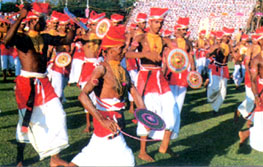|
Velakali
 Velakali, a dance evolve from the martial culture, is performed
in some temples as a spectacle during festivals in which the whole
village participates. This dance originated in Ambalapuzha which gained
importance in the16th century AD as a coastal principality ruled by a
Brahmin Raja having the family name 'Devanarayana'. Most of these Rajas
were great patrons of art and learning.
Velakali, a dance evolve from the martial culture, is performed
in some temples as a spectacle during festivals in which the whole
village participates. This dance originated in Ambalapuzha which gained
importance in the16th century AD as a coastal principality ruled by a
Brahmin Raja having the family name 'Devanarayana'. Most of these Rajas
were great patrons of art and learning.
One Devanarayana who lived
in the18th century had encouraged many poets and artists in
his royal court. During the 17-18th centuries, the coastal
principality of Ambalpuzha had commercial contacts with the Portuguese
and Dutch. Several wars were fought in the sea with these powers by the
raja and his predecessors. Velakali was conceived as a reminiscence of
these armed conflicts, a re-enactment of those wars waged in the
sea and land. The dance form assumed the shape of an earlier art
called Naikkan Tullal.
Velakali is basically a group dance held in the open
air as an exhibition of the martial feats in front of the raja
of Ambalapuzha, who wanted to see how his soldiers had waged the battles.
This show meant to be witnessed by the deity of the temple which is taken
out in procession to the courtyard of the temple on a caparisoned
elephant. The play consist of a procession in the beginning in which,
the dancers walk in line through the village road holding the sword made
of rattan in the right-hand and a shield in the left. They move
elegantly keeping their pace to the rhythm followed by a hilarious
group of villagers encouraging the dancers by jumping and singing and
waving small colourful flags.
By dusk 'Kulathil vela' or the play on the
bank of the tank commences. The dancers take their position on the bank
of the temple tank and with weapons in their hands start the play
moving their bodies. Their movements get reflected in the water
probably reminding one of the war in the sea or lakes. On the other side
of the tank the caparisoned elephant with the deity takes position.
The dancers do not change their position but exhibit only the swaying
of their bodies to the rhythm of Velappara, the main percussion instrument.
Then the dancers disperse to assemble again in the southern quadrangle
of the temple to start the regular exhibition of the feats. There the
deity appears on the elephant. By about 8.p.m 'Tirumunpil vela' or the
play before the divine presence of the deity, start. All the numbers in
the repertoire of Velakali, consisting of solo, dual and group performances
of the Payattu (fight) are shown in detail.
|


 Velakali, a dance evolve from the martial culture, is performed
in some temples as a spectacle during festivals in which the whole
village participates. This dance originated in Ambalapuzha which gained
importance in the16th century AD as a coastal principality ruled by a
Brahmin Raja having the family name 'Devanarayana'. Most of these Rajas
were great patrons of art and learning.
Velakali, a dance evolve from the martial culture, is performed
in some temples as a spectacle during festivals in which the whole
village participates. This dance originated in Ambalapuzha which gained
importance in the16th century AD as a coastal principality ruled by a
Brahmin Raja having the family name 'Devanarayana'. Most of these Rajas
were great patrons of art and learning.